manual transmission HYUNDAI GENESIS G80 2012 User Guide
[x] Cancel search | Manufacturer: HYUNDAI, Model Year: 2012, Model line: GENESIS G80, Model: HYUNDAI GENESIS G80 2012Pages: 332, PDF Size: 20.46 MB
Page 234 of 332
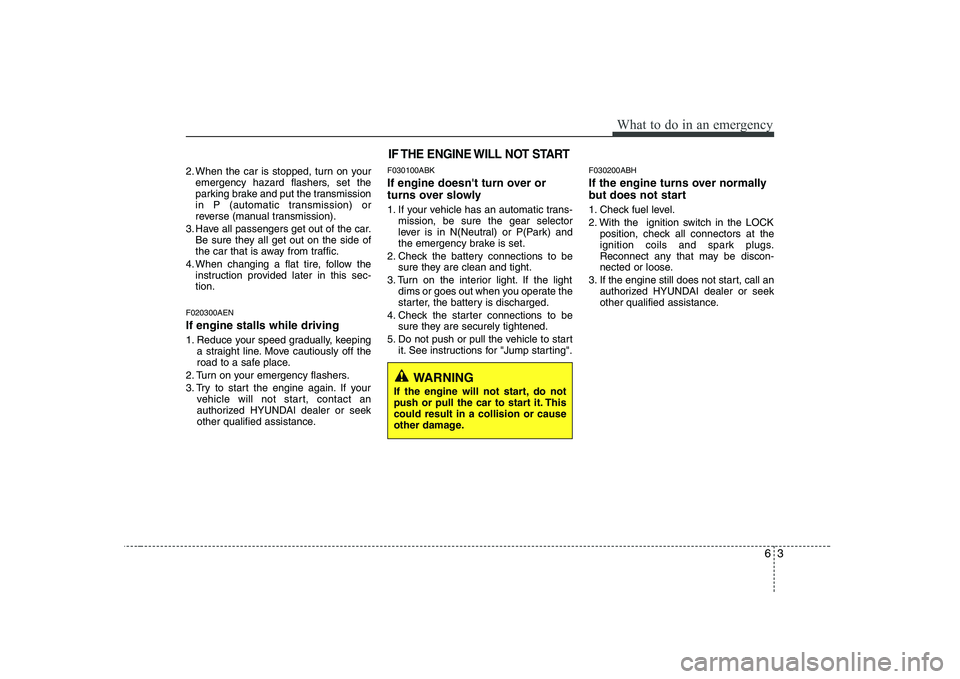
63
What to do in an emergency
2. When the car is stopped, turn on youremergency hazard flashers, set the
parking brake and put the transmission
in P (automatic transmission) or
reverse (manual transmission).
3. Have all passengers get out of the car. Be sure they all get out on the side of
the car that is away from traffic.
4. When changing a flat tire, follow the instruction provided later in this sec-tion.
F020300AEN If engine stalls while driving
1. Reduce your speed gradually, keeping a straight line. Move cautiously off the
road to a safe place.
2. Turn on your emergency flashers.
3. Try to start the engine again. If your vehicle will not start, contact an
authorized HYUNDAI dealer or seek
other qualified assistance. F030100ABK
If engine doesn't turn over or
turns over slowly
1. If your vehicle has an automatic trans-
mission, be sure the gear selector
lever is in N(Neutral) or P(Park) and
the emergency brake is set.
2. Check the battery connections to be sure they are clean and tight.
3. Turn on the interior light. If the light dims or goes out when you operate the
starter, the battery is discharged.
4. Check the starter connections to be sure they are securely tightened.
5. Do not push or pull the vehicle to start it. See instructions for "Jump starting". F030200ABH
If the engine turns over normally
but does not start
1. Check fuel level.
2. With the ignition switch in the LOCK
position, check all connectors at the
ignition coils and spark plugs.
Reconnect any that may be discon-
nected or loose.
3. If the engine still does not start, call an authorized HYUNDAI dealer or seek
other qualified assistance.
IF THE ENGINE WILL NOT START
WARNING
If the engine will not start, do not
push or pull the car to start it. Thiscould result in a collision or cause
other damage.
Page 236 of 332
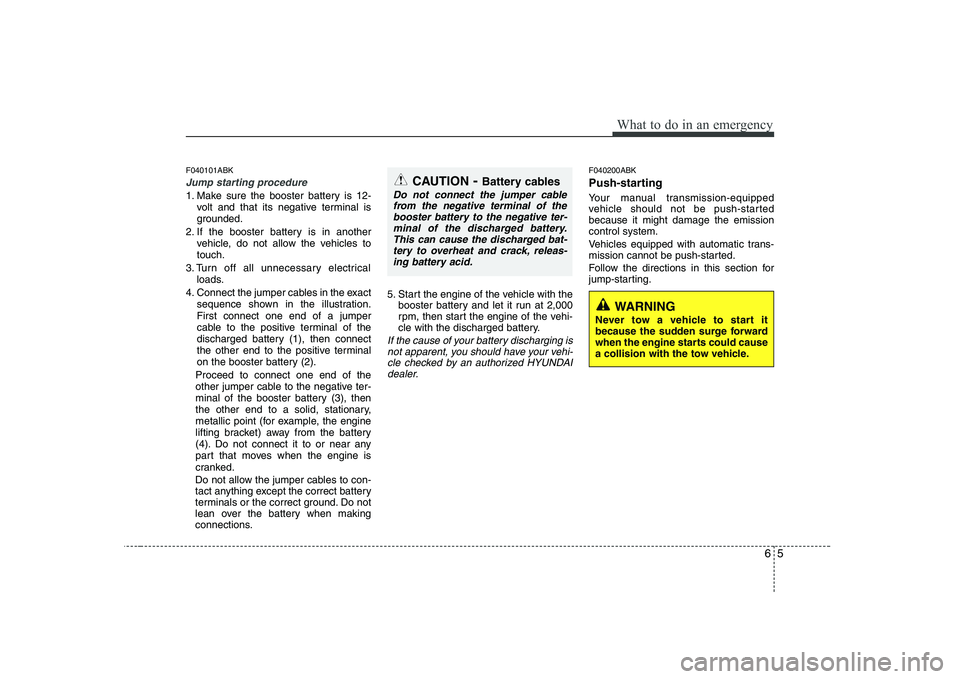
65
What to do in an emergency
F040101ABK
Jump starting procedure
1. Make sure the booster battery is 12-volt and that its negative terminal is
grounded.
2. If the booster battery is in another vehicle, do not allow the vehicles totouch.
3. Turn off all unnecessary electrical loads.
4. Connect the jumper cables in the exact sequence shown in the illustration.First connect one end of a jumper
cable to the positive terminal of the
discharged battery (1), then connect
the other end to the positive terminal
on the booster battery (2).
Proceed to connect one end of the
other jumper cable to the negative ter-
minal of the booster battery (3), then
the other end to a solid, stationary,
metallic point (for example, the engine
lifting bracket) away from the battery
(4). Do not connect it to or near any
part that moves when the engine is
cranked.
Do not allow the jumper cables to con-
tact anything except the correct battery
terminals or the correct ground. Do not
lean over the battery when making
connections. 5. Start the engine of the vehicle with the
booster battery and let it run at 2,000
rpm, then start the engine of the vehi-
cle with the discharged battery.
If the cause of your battery discharging is
not apparent, you should have your vehi-
cle checked by an authorized HYUNDAIdealer.
F040200ABK
Push-starting
Your manual transmission-equipped
vehicle should not be push-startedbecause it might damage the emissioncontrol system.
Vehicles equipped with automatic trans-
mission cannot be push-started.
Follow the directions in this section for
jump-starting.
WARNING
Never tow a vehicle to start it
because the sudden surge forward
when the engine starts could cause
a collision with the tow vehicle.
CAUTION - Battery cables
Do not connect the jumper cable
from the negative terminal of the booster battery to the negative ter-minal of the discharged battery.
This can cause the discharged bat-tery to overheat and crack, releas-ing battery acid.
Page 237 of 332
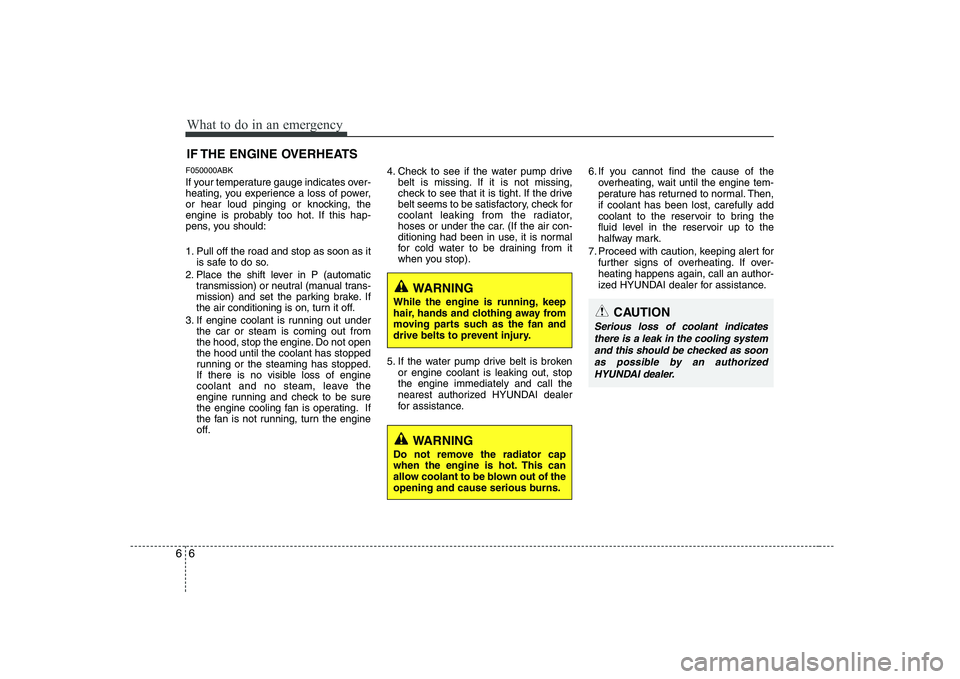
What to do in an emergency
6
6
IF THE ENGINE OVERHEATS
F050000ABK
If your temperature gauge indicates over-
heating, you experience a loss of power,
or hear loud pinging or knocking, the
engine is probably too hot. If this hap-
pens, you should:
1. Pull off the road and stop as soon as it is safe to do so.
2. Place the shift lever in P (automatic transmission) or neutral (manual trans-
mission) and set the parking brake. If
the air conditioning is on, turn it off.
3. If engine coolant is running out under the car or steam is coming out from
the hood, stop the engine. Do not openthe hood until the coolant has stopped
running or the steaming has stopped.
If there is no visible loss of engine
coolant and no steam, leave the
engine running and check to be sure
the engine cooling fan is operating. If
the fan is not running, turn the engine
off. 4. Check to see if the water pump drive
belt is missing. If it is not missing,
check to see that it is tight. If the drive
belt seems to be satisfactory, check for
coolant leaking from the radiator,
hoses or under the car. (If the air con-
ditioning had been in use, it is normal
for cold water to be draining from it
when you stop).
5. If the water pump drive belt is broken or engine coolant is leaking out, stop the engine immediately and call the
nearest authorized HYUNDAI dealer
for assistance. 6. If you cannot find the cause of the
overheating, wait until the engine tem-
perature has returned to normal. Then,if coolant has been lost, carefully add
coolant to the reservoir to bring the
fluid level in the reservoir up to the
halfway mark.
7. Proceed with caution, keeping alert for further signs of overheating. If over-heating happens again, call an author-
ized HYUNDAI dealer for assistance.
WARNING
While the engine is running, keep
hair, hands and clothing away from
moving parts such as the fan and
drive belts to prevent injury.
WARNING
Do not remove the radiator cap
when the engine is hot. This can
allow coolant to be blown out of the
opening and cause serious burns.
CAUTION
Serious loss of coolant indicates there is a leak in the cooling systemand this should be checked as soonas possible by an authorized HYUNDAI dealer.
Page 239 of 332
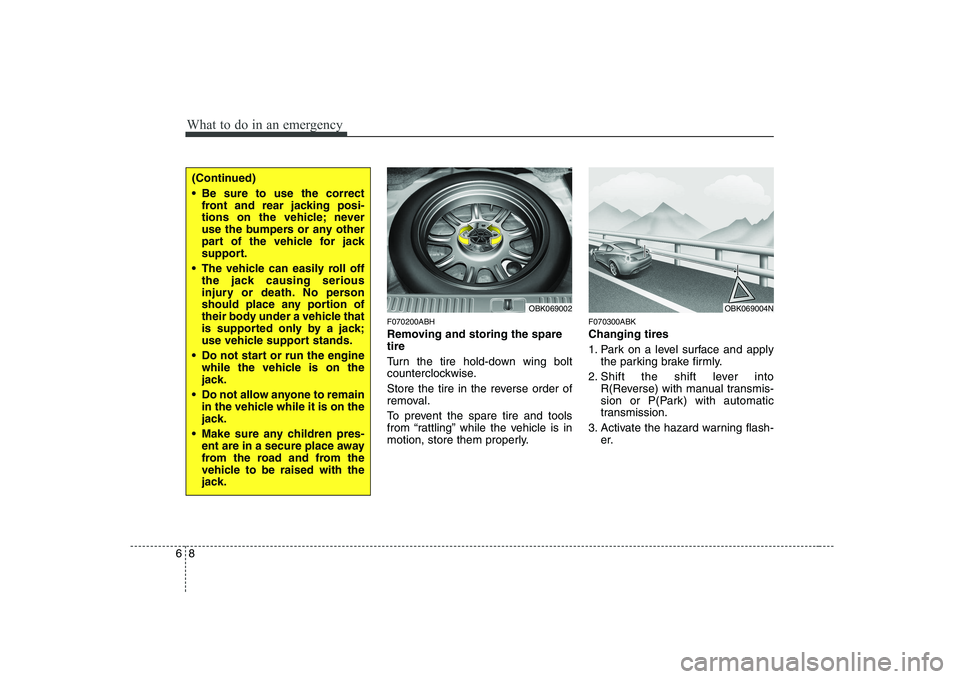
What to do in an emergency
8
6
F070200ABH
Removing and storing the spare tire
Turn the tire hold-down wing bolt
counterclockwise.
Store the tire in the reverse order of
removal.
To prevent the spare tire and tools
from “rattling” while the vehicle is in
motion, store them properly. F070300ABK Changing tires
1. Park on a level surface and apply
the parking brake firmly.
2. Shift the shift lever into R(Reverse) with manual transmis-
sion or P(Park) with automatic
transmission.
3. Activate the hazard warning flash- er.
OBK069002
(Continued)
Be sure to use the correctfront and rear jacking posi-
tions on the vehicle; never
use the bumpers or any other
part of the vehicle for jack
support.
The vehicle can easily roll off the jack causing serious
injury or death. No person
should place any portion of
their body under a vehicle that
is supported only by a jack;
use vehicle support stands.
Do not start or run the engine while the vehicle is on the
jack.
Do not allow anyone to remain in the vehicle while it is on the
jack.
Make sure any children pres- ent are in a secure place away
from the road and from the
vehicle to be raised with the
jack.
OBK069004N
Page 251 of 332
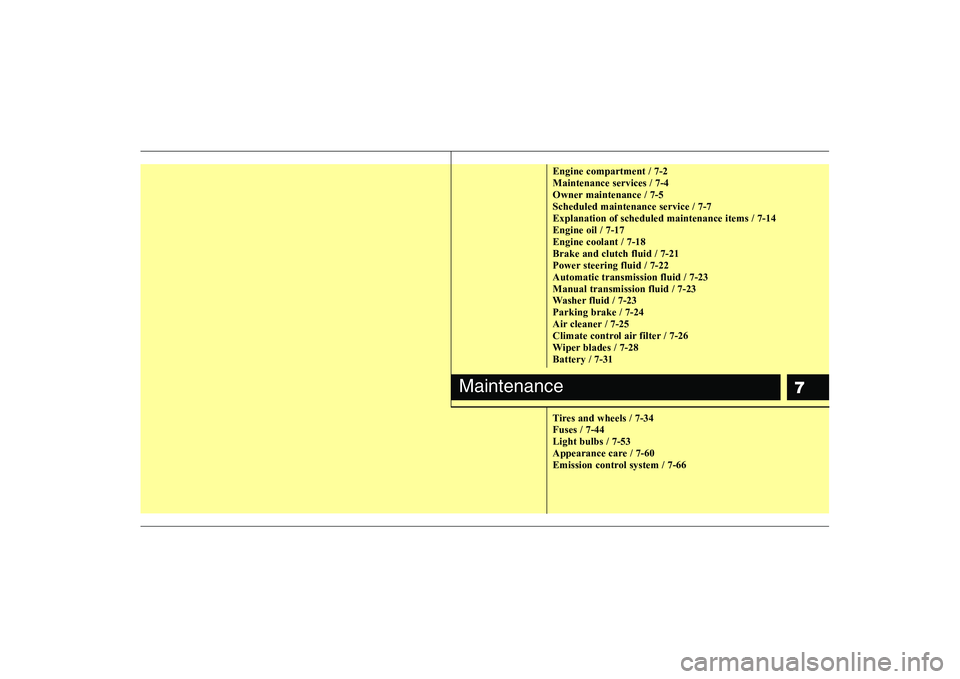
7
Engine compartment / 7-2 Maintenance services / 7-4
Owner maintenance / 7-5Scheduled maintenance service / 7-7Explanation of scheduled maintenance items / 7-14Engine oil / 7-17Engine coolant / 7-18Brake and clutch fluid / 7-21
Power steering fluid / 7-22Automatic transmission fluid / 7-23Manual transmission fluid / 7-23
Washer fluid / 7-23Parking brake / 7-24
Air cleaner / 7-25
Climate control air filter / 7-26
Wiper blades / 7-28Battery / 7-31
Tires and wheels / 7-34 Fuses / 7-44Light bulbs / 7-53
Appearance care / 7-60
Emission control system / 7-66
Maintenance
Page 261 of 332

711
Maintenance
NORMAL MAINTENANCE SCHEDULE (CONT.)
I : Inspect and if necessary, adjust, correct, clean or replace.
R : Replace or change.*9
: Rear axle oil should be changed anytime they have been submerged in water.
Number of months or driving distance, whichever comes first
Months 12 24 36 48 60 72 84 96
Miles×1,000 10 20 30 40 50 60 70 80
Km×1,000 15 30 45 60 75 90 105 120
Power steering fluid and hoses I I I I I I I I
Steering gear rack, linkage and boots I I I I I I I I
Driveshaft and boots I I I I
Tire (pressure & tread wear) I I I I I I I I
Front suspension ball joints I I I I I I I I
Bolt and nuts on chassis and body I I I I I I I I
Air conditioner refrigerant (if equipped) I I I I I I I I
Air conditioner compressor (if equipped) I I I I I I I I Climate control air filter (if equipped)
For EuropeRRRR
Except EuropeRRR RRRRR
Manual transmission fluid I I I I I I I I
Automatic transmission fluid (2.0 TCI)
For EuropeIII IIRII
Except EuropeIII IIIII
Rear axle oil* 9IIII
Propeller shaft I I I I
MAINTENANCE
INTERVALS
MAINTENANCE ITEM
Page 262 of 332

Maintenance
12
7
G040200ABK
MAINTENANCE UNDER SEVERE USAGE CONDITIONS
The following items must be serviced more frequently on cars mainly used under severe driving conditions.
Refer to the chart below for the appropriate maintenance intervals.
R : Replace I : Inspect and if necessary, adjust, correct, clean or replace
Engine oil and 2.0 TCI R Every 5,000 km (3,000 miles) or 3 months
A, B, C, D, E, F,
engine oil filter 3.8L For Middle East R Every 5,000 km (3,000 miles) or 6 months
G, H, I, K, L
Except Middle East R Every 7,500 km (4,500 miles) or 6 months
Air cleaner element R C, E
Spark plugs R B, H
Manual transmission fluid R Every 100,000 km (62,000 miles) C, D, E, G, H, I, K
Automatic 2.0 TCI For Europe R Every 45,000 km (30,000 miles)
A, C, D, E, F
transmission fluid Except Europe R Every 40,000 km (25,000 miles)
G, H, I
3.8L R Every 80,000 km (50,000 miles)
Steering gear rack, linkage and boots I C, D, E, F, G
Rear axle oil R Every 120,000 km (75,000 miles) C, E, G, H, I, K
MAINTENANCE ITEMMaintenance
operation Maintenance intervals
Driving condition
Replace more frequently
depending on the condition
Inspect more frequently
depending on the condition Replace more frequently
depending on the condition
Page 265 of 332

715
Maintenance
G050600AUN
Vapor hose and fuel filler cap
The vapor hose and fuel filler cap should
be inspected at those intervals specified
in the maintenance schedule. Make sure
that a new vapor hose or fuel filler cap iscorrectly replaced.
G050700AUN
Vacuum crankcase ventilation hoses (if equipped)
Inspect the surface of hoses for evidence
of heat and/or mechanical damage. Hard
and brittle rubber, cracking, tears, cuts,
abrasions, and excessive swelling indi-
cate deterioration. Particular attention
should be paid to examine those hose
surfaces nearest to high heat sources,
such as the exhaust manifold. Inspect the hose routing to assure that the hoses do not come in contact with
any heat source, sharp edges or movingcomponent which might cause heat dam-
age or mechanical wear. Inspect all hose
connections, such as clamps and cou-
plings, to make sure they are secure, and
that no leaks are present. Hoses should
be replaced immediately if there is any
evidence of deterioration or damage.G050800AEN
Air cleaner filter
A Genuine HYUNDAI air cleaner filter is recommended when the filter isreplaced.
G050900AUN Spark plugs
Make sure to install new spark plugs of
the correct heat range. G051000AEN
Valve clearance
Inspect excessive valve noise and/or
engine vibration and adjust if necessary.
An authorized HYUNDAI dealer should
perform the operation.
G051100AUN Cooling system
Check cooling system components, such
as radiator, coolant reservoir, hoses and
connections for leakage and damage.
Replace any damaged parts.
G051200AUN Coolant The coolant should be changed at the
intervals specified in the maintenance
schedule. G051300ABK
Manual transmission (if equipped)
Inspect the manual transmission fluid
according to the maintenance schedule. G051400ABK
Automatic transmission fluid (if equipped)
Inspect the automatic transmission fluid
according to the maintenance schedule.
G051500AUN Brake hoses and lines
Visually check for proper installation,
chafing, cracks, deterioration and any
leakage. Replace any deteriorated or
damaged parts immediately.
Page 273 of 332
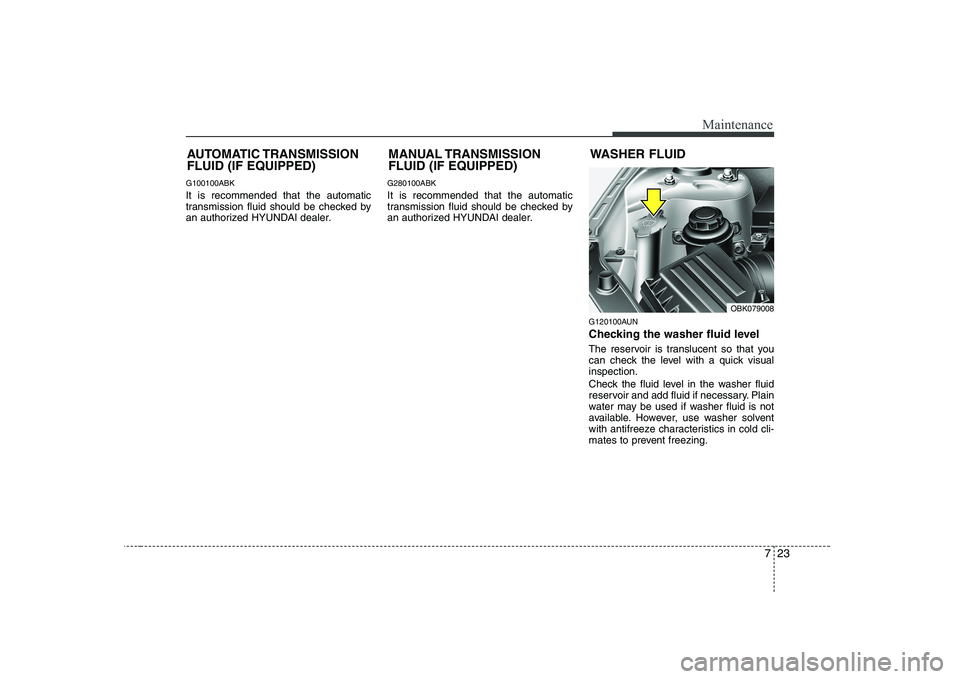
723
Maintenance
G100100ABK It is recommended that the automatic
transmission fluid should be checked by
an authorized HYUNDAI dealer.G280100ABK It is recommended that the automatic
transmission fluid should be checked by
an authorized HYUNDAI dealer.
G120100AUN
Checking the washer fluid level
The reservoir is translucent so that you
can check the level with a quick visualinspection.
Check the fluid level in the washer fluid
reservoir and add fluid if necessary. Plain
water may be used if washer fluid is not
available. However, use washer solvent
with antifreeze characteristics in cold cli-
mates to prevent freezing.
AUTOMATIC TRANSMISSION
FLUID (IF EQUIPPED) MANUAL TRANSMISSION
FLUID (IF EQUIPPED) WASHER FLUID
OBK079008
Page 322 of 332
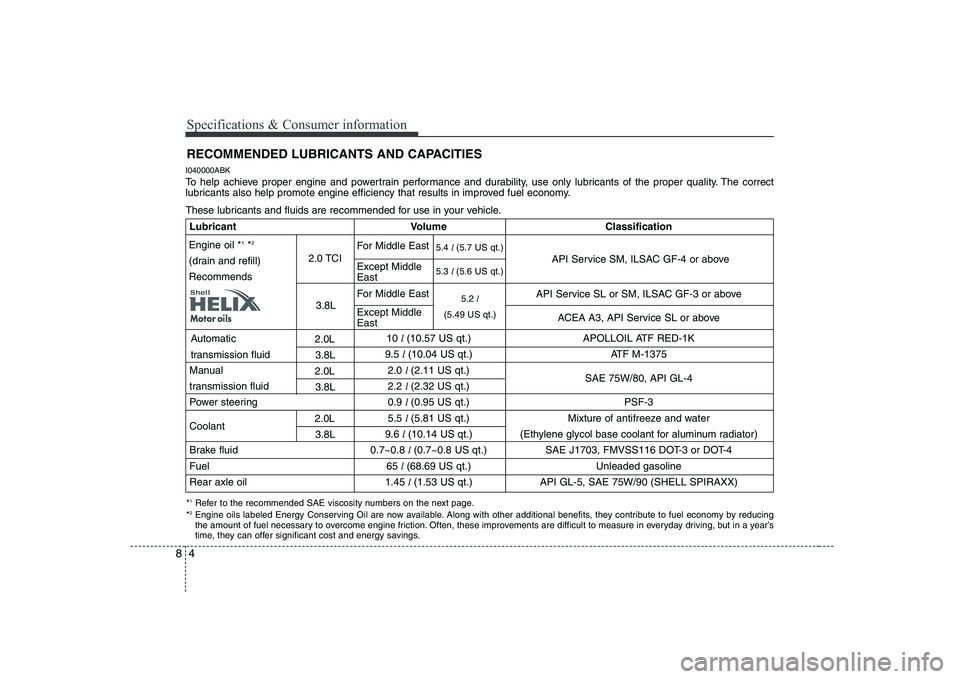
Specifications & Consumer information
4
8
RECOMMENDED LUBRICANTS AND CAPACITIES
I040000ABK
To help achieve proper engine and powertrain performance and durability, use only lubricants of the proper quality. The correct
lubricants also help promote engine efficiency that results in improved fuel economy.
These lubricants and fluids are recommended for use in your vehicle.
* 1
Refer to the recommended SAE viscosity numbers on the next page.
* 2
Engine oils labeled Energy Conserving Oil are now available. Along with other additional benefits, they contribute to fuel econo my by reducing
the amount of fuel necessary to overcome engine friction. Often, these improvements are difficult to measure in everyday driving, but in a year’s
time, they can offer significant cost and energy savings.
Lubricant Volume Classification
API Service SL or SM, ILSAC GF-3 or aboveACEA A3, API Service SL or above
10 l (10.57 US qt.) APOLLOIL ATF RED-1K
9.5 l (10.04 US qt.) ATF M-1375
Manual 2.0 l (2.11 US qt.)
SAE 75W/80, API GL-4
transmission fluid 2.2 l (2.32 US qt.)
Power steering 0.9 l (0.95 US qt.) PSF-3
Coolant 5.5
l (5.81 US qt.) Mixture of antifreeze and water
9.6 l (10.14 US qt.) (Ethylene glycol base coolant for aluminum radiator)
Brake fluid 0.7~0.8 l (0.7~0.8 US qt.) SAE J1703, FMVSS116 DOT-3 or DOT-4
Fuel 65 l (68.69 US qt.) Unleaded gasoline
Rear axle oil 1.45 l (1.53 US qt.) API GL-5, SAE 75W/90 (SHELL SPIRAXX)
Engine oil * 1
*2
(drain and refill) Recommends 2.0 TCI
3.8L
Automatic
transmission fluid
2.0L3.8L
2.0L
3.8L
2.0L
3.8L API Service SM, ILSAC GF-4 or above5.4
l (5.7 US qt.)
5.3 l (5.6 US qt.)
5.2 l
(5.49 US qt.)
Except Middle East
For Middle East
Except Middle East
For Middle East